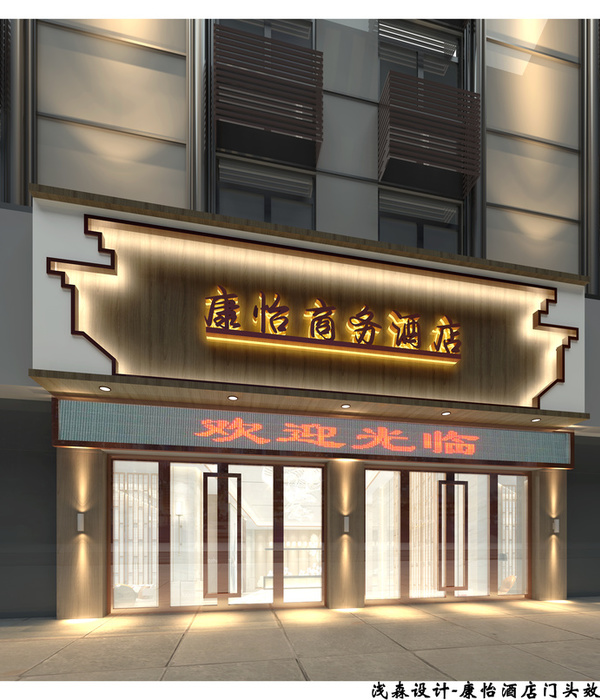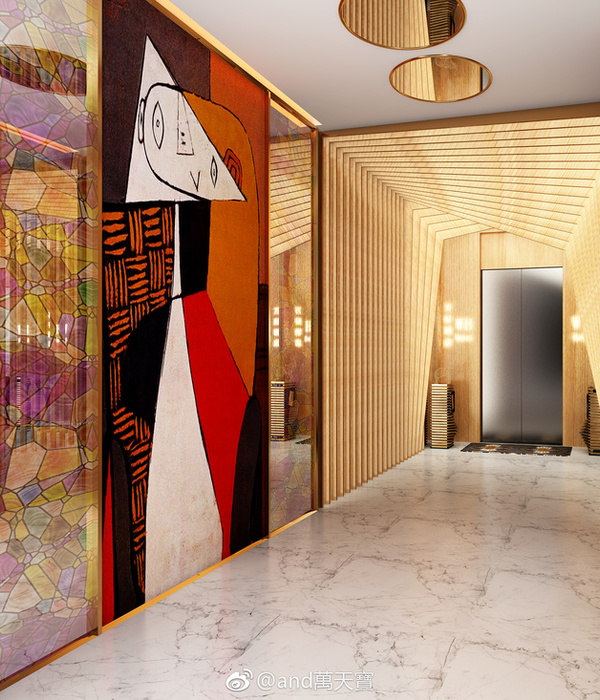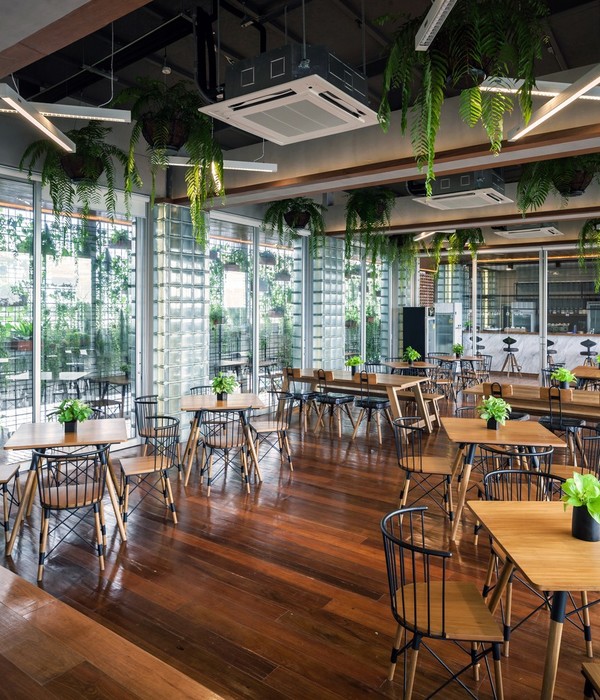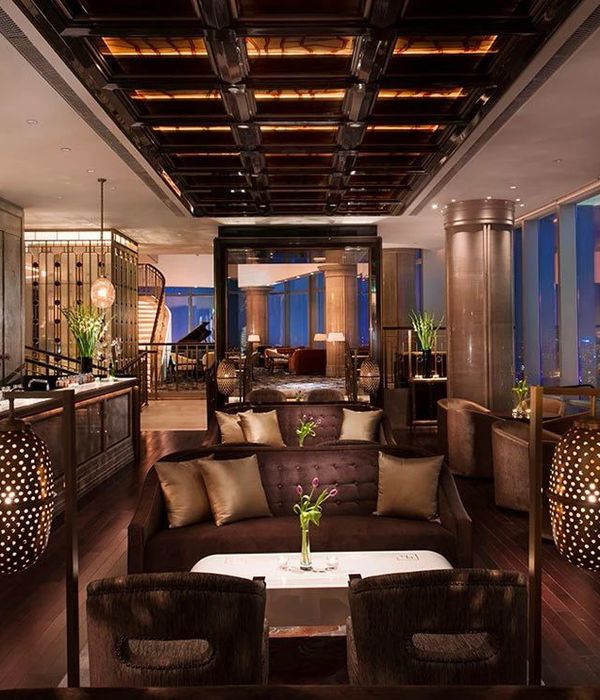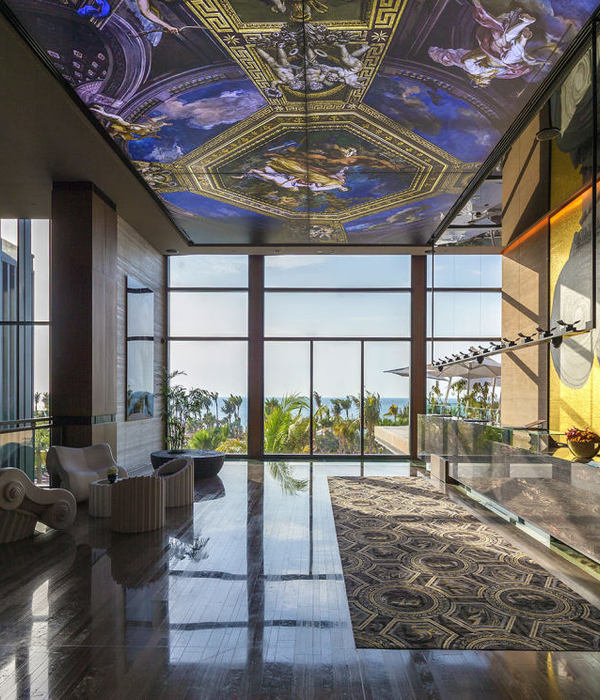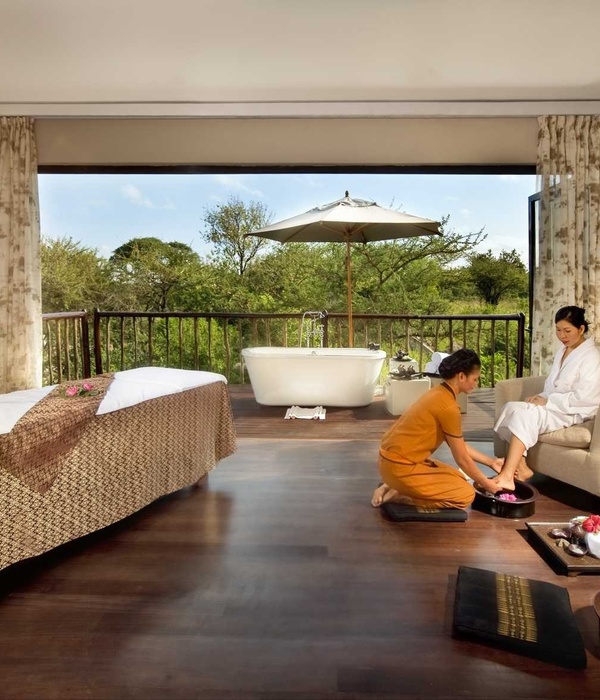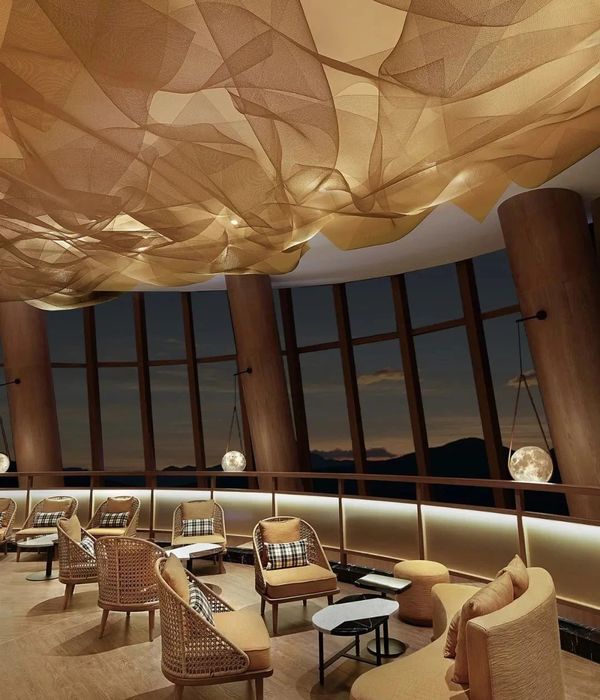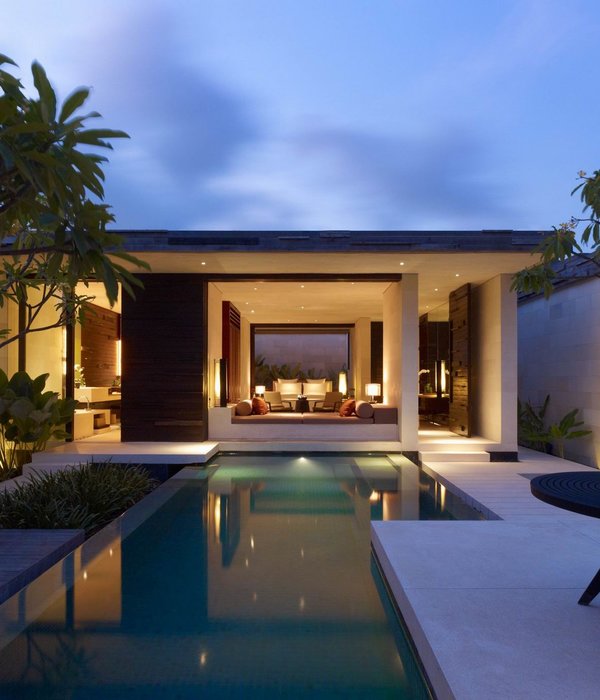建于一个当代温泉水疗和别墅区中,202 村·民宿结合了传统工艺和实验技术,以及研究与设计的建筑策略,将现代与传统生活融为一体。该选址的历史可以追溯到公元 202 年,位于一座山谷中,直到最近几年才可以乘船进入。由于该地区竹林十分常见,竹工艺品和篮子编织的丰富传统成为了是该地区文化遗产的一部分。
全景鸟瞰,general view©John Lin and Olivier Ottevaere
In a contemporary hot spring spa and villa complex, the 202 Village Guesthouses brings modern and traditional living together through an architectural strategy that combines traditional craft and experimental techniques in a blend of research and design. With a long history dating back to the year 202 AD, the site is located in a valley that has been only accessible by boat until recent years. Bamboo forests are common and a rich tradition of bamboo crafts and basket weaving is part of this area’s cultural heritage.
▼场地正面鸟瞰,aerial frontal view©John Lin and Olivier Ottevaere
▼客房建筑鸟瞰,houses aerial view©John Lin and Olivier Ottevaere
这座建筑具体位于陡峭的山谷中,下方有河流。从远看,建筑本体看似一系列由木材和混凝土制成的山峰和山谷。从屋顶进入接待中心后,便能够看到历史悠久的河谷,其周围是起伏的屋顶,由竹子和织物模铸造成。该建筑的结构一半是当地的传统木结构,另一半是典低成本混凝土构造,是一种不寻常的组合。竹子的自然特质变得显而易见,柔软的织物和竹竿的不规则性结合,创造出一种动感的混凝土“窗帘”,让人联想到附近的竹林。
▼场地平面图,site plan©John Lin and Olivier Ottevaere
Situated along the side of a steep valley sloping down to the river, the architecture takes some time to reveal itself, at first appearing to be a series of peaks and valleys, made in timber and concrete. Upon entering the reception center from the roof level, the view opens up to the historic river valley, framed by an undulating roof that has been cast with bamboo and fabric formwork. Built half in concrete and half in wood, the structure is an unusual combination of crafting with local materials and typical low-cost concrete construction. The natural qualities of the bamboo become apparent where the combination of soft fabric and the irregularity of the bamboo poles creates a moving “curtain” of concrete that is reminiscent of the bamboo forests nearby.
主体建筑外观,hotel completed view outside©John Lin and Olivier Ottevaere
酒店主体建筑立面,hotel roof front view completed©John Lin and Olivier Ottevaere
酒店屋顶和客房建筑,hotel roof and house©John Lin and Olivier Ottevaere
▼屋顶景观,curve roof timber landscape©John Lin and Olivier Ottevaere
▼接待中心内部,interior reception concrete curve©John Lin and Olivier Ottevaere
接待中心和室外露台,reception and outdoor terrace©John Lin and Olivier Ottevaere
▼从室内望向混凝土屋顶,interior concrete curve©John Lin and Olivier Ottevaere
通过别墅的布局及框景的手法,山谷的风景在不同的距离展现在众人面前。该民宿由 7 栋别墅组成,每栋别墅的设计都是对传统侗族木结构的进一步研究和发展。该设计保留了原来的传统框架结构,同时结合了一组创新的平面图。由于山区的地形限制,能提供的建筑空间数量有限。因此,每栋别墅都拥有独特和私人的风景,同时结合了单个和多个家庭单元的变化。在每间卧室内,都能够感觉到仿佛这片风景只因你而存在。
The views of the valley continue to be framed in close up and distant ways through the arrangement of the villas. The resort consists of 7 villas, each one designed as a further research and evolution of the traditional dong minority wooden house construction. The traditional frame structure of the dong craftspeople is retained, but combined in a unique set of floor plans. Because of the highly constrained nature of the mountainous site, only a limited number of building locations was available. Therefore, each villa orients itself towards a unique and private view, while combining variations of single and multiple family units. Within each and every bedroom, there is the feeling that the landscape exists just for you.
▼客房建筑鸟瞰,houses aerial view©John Lin and Olivier Ottevaere
客房建筑外观,houses exterior view©John Lin and Olivier Ottevaere
▼框景,rocks framed©John Lin and Olivier Ottevaere
室内砖墙和木结构,interior brick wall timber structure©John Lin and Olivier Ottevaere
▼室内复杂的木结构,complex wooden structure©John Lin and Olivier Ottevaere
卧室,interior bedroom©John Lin and Olivier Ottevaere
客房 spa 区,interior spa©John Lin and Olivier Ottevaere
此外,该民宿的水疗中心是为了对竹竿和织物模板进行进一步试验而建造的。通过向其中一个混凝土壳体填充水,使施工技术的坚固性更进一步。这种技术形成了在倾斜的地形下的悬臂式海滩游泳池,而在其波纹状天花板下方,则创造了一个安静而隐蔽的沐浴和放松空间。
Finally, the spa was built as a further experimentation with the responsive bamboo/fabric formwork; taking the robustness of the construction technique a step further by filling one of its shells with water. As a result, and at odds with gravity, a cantilevered beach pool emerges from the sloped terrain, while beneath its corrugated ceiling, a tranquil and concealed space for bathing and relaxation is created.
▼泳池鸟瞰,pool aerial view©John Lin and Olivier Ottevaere
悬臂式海滩游泳池,the cantilevered beach pool©John Lin and Olivier Ottevaere
202 村·民宿 是一次独特的知识交流合作项目。由香港大学的 John Lin(林君翰)和 Olivier Ottevaere 与当地合伙人建筑师邢村(张本和光辉龙)的带领下,该项目涉及了一系列的实验性建筑。 方曾经合作过建造三个木凉亭:Pinch(捏), Sweep(扫)and Warp(扭曲),而这次的项目是之前实验的结果。这些震后修复项目的重点是通过利用线性几何形状来适应特定地点的实际情况,以振兴木材建筑。
酒店剖面图(以木制屋顶为截面),cross-section through timber roof©John Lin and Olivier Ottevaere
▼剖面图(以混凝土外壳为截面),cross-section through concrete shell©John Lin and Olivier Ottevaere
The 202 Village Guesthouses is conducted as a unique knowledge exchange collaboration with John Lin and Olivier Ottevaere from The University of Hong Kong. With local partner architects, Xingcun (Ben Zhang and Guang Huilong), this project involves a series of experimental constructions that are the result of a collaboration which previously included three built wooden pavilions: Pinch, Sweep and Warp. These post-earthquake rehabilitation projects focused on revitalizing timber construction by utilizing linear geometries adapted to highly site-specific situations.
混凝土和木制屋顶施工,concrete timber roof construction©John Lin and Olivier Ottevaere
▼檐下视角 & 泳池竹制屋顶施工,view from below & construction pool bamboo©John Lin and Olivier Ottevaere
这次项目中,林先生和 Ottevaere 先生探索了一个崭新的设计方向 – 如何运用织物和竹竿的线性几何造成混凝土壳的基础模板。受到竹林和竹筐编织工艺的启发,他们有意识地努力弥合手工艺与建筑之间的鸿沟,以发展和改变这些重要的传统。竹竿用于说明一系列旋转直线,描述了每个壳体的特定双曲线几何形状。为了弥补每根杆之间留下的不规则间隙,他们决定拉长一大片布料来覆盖竹顶。
竹子与织物:一种硬,一种软,两种材料展现出了一种新颖的模板技术。该技术使模板可重复利用,并响应了混凝土的独特性能 – 例如液体压力。铸造时,竹竿的波纹会在混凝土壳下浮现。模板材料和液态混凝土互相的作用力赋予了材料的最终的形态。
▼轴测拆解图,scaffold axo©John Lin and Olivier Ottevaere
In this recent project, Lin and Ottevaere explore a new variation, where the use of linear geometry is the basis for casting concrete shells on a formwork made of fabric and bamboo poles. Inspired by the bamboo forests and the intricacies of bamboo basket making, there was a conscious effort to bridge the gap between handicraft and architecture in order to evolve and transform these important traditions. Bamboo poles are used to account for a series of rotating straight lines, describing the specific doubly-curved geometry of each shell. To compensate for the irregular gaps left open between each pole, large sheets of fabric are stretched to cover the bamboo top.
Together, bamboo and fabric or hard and soft materials put forward a novel formwork technique that becomes adaptable, reusable and responsive to the unique properties of concrete; such as liquid pressure. Upon casting, corrugations are registered on the underneath surface of the concrete shells. They are the result of the active participation of the formwork materials with the live forces of the liquid concrete which ultimately give them their final form.
▼竹竿用于说明一系列旋转直线,bamboo poles are used to account for a series of rotating straight lines©John Lin and Olivier Ottevaere
▼布料覆盖竹顶 & 混凝土外壳,large sheets of fabric are stretched to cover the bamboo top & concrete shell©John Lin and Olivier Ottevaere
混凝土屋顶细节,concrete curve hotel roof detail©John Lin and Olivier Ottevaere
这种经济高效的建筑技术简单且灵活,可以轻松地教会当地的外行者。需要运用的材料不仅便宜且容易获得,同时还可以灵活地适应各种形状和形态。根据当地需要,无论柱到墙,还是梁到屋顶,都可以利用此施工技术来实现。通过运用当地材料和技术,该项目探讨了在这种特定情况下固有的可能性,并重申通过与多种建筑传统的紧密联系,可以使建筑理想更上一层楼。
This economical and efficient building technique proposes a straightforward and expedient technology that is easily transferrable to local laymen. It does so not only by making use of cheap and readily available materials, but also by being flexible in the various shapes and forms that can be realized with this construction technique alone based on local needs, ranging in types from column to wall to beam to roof. Working with local materials and techniques while exploring the possibilities inherent in this specific context, the project reaffirms that the advancement of architectural ideas is achieved hand-in-hand with a deep connection to multiple building traditions.
▼场地平面,site plan©John Lin and Olivier Ottevaere
▼酒店夜景,hotel completed night view©John Lin and Olivier Ottevaere
▼正立面图,front elevation©John Lin and Olivier Ottevaere
▼天花板底部透视,bottom perspective©John Lin and Olivier Ottevaere
结构几何形态,structure geometry©John Lin and Olivier Ottevaere
▼立面展开图,unfolding©John Lin and Olivier Ottevaere
▼屋顶轮廓线,progression of the rooflines©John Lin and Olivier Ottevaere
壳体平面,shell plan©John Lin and Olivier Ottevaere
壳体剖面图,shell sections©John Lin and Olivier Ottevaere
▼室内平面图,interior floor plan©John Lin and Olivier Ottevaere
▼客房平面图,room plans©John Lin and Olivier Ottevaere
202 Village Guesthouses 202 村·民宿 Design: John Lin and Olivier Ottevaere at The University of Hong Kong 设计:林君翰和 Olivier Ottevaere(香港大学)Local Architect: Xingcun (Ben Zhang 张清源 and Guan Huilong 关慧龙) 本地建筑师:行村建筑设计事务所 Research Assistants: Josephine Saabye, Zubin Singh, Xia Chengwei, Liu Chang, Bo Yee Lau, Haotian Zhang, Chiara Oggioni Project location: Baojing, Hunan Province, China 项目地区:中国湖南保靖县 Completion year: 2021 完成年份:2021 Size: 2570 sqm 尺寸:2570sqm Cost:14 million rmb 费用:1400 万人民币 Client: Baojing Local Government 委托人:保靖县本地政府
{{item.text_origin}}

